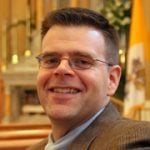
In the ninth century, after the death of Pope St. Nicholas the Great in 867, the Catholic Church entered into a dark chapter for the papacy. During this time, there were only two papal saints, Nicholas I and Adrian III (r. 884-885) from 867 to 1042—a timeline of 182 years and forty-four popes! The papacy was not only absent saintliness in its occupants, but also was witness to high crimes, scandal, and macabre events. No fewer than twelve pontiffs from the late ninth through the mid-eleventh century were murdered—poisoned, strangled, suffocated, or bludgeoned—or died under mysterious circumstances. The papacy became a dangerous place due to the machinations of local noble Italian families and other regional rulers who vied to control the important position.
This “game of thrones” environment is best illustrated in the five-year pontificate of Pope Formosus (r. 891-896) at the end of the ninth century. Formosus was a well known churchman and a contentious figure in Christendom before his papal election. Once pope, Formosus became embroiled in the political question concerning the holy roman emperor. In 891, Pope Stephen VI (r. 885-891) crowned one Guy of Spoleto, a ferocious warlord with a band of Muslim mercenaries at his disposal. But Formosus backed different men at different times depending on the political situation—eventually resulting in one of the contenders invading Italy with a large army. Formosus’s troubles ended only when he died on Easter Sunday 896 at the age of eighty.
The next pope, Boniface VI, reigned for two weeks only before his death and was replaced by Stephen VII (r. 896–897). Stephen’s short pontificate was witness to one of the most ghoulish scenes in Church history. Angry at the behavior of Pope Formosus over the imperial title, the spurned Lambert II of Spoleto entered Rome in 897 and demanded that Stephen VII place his deceased predecessor on trial for alleged violations of canon law. Sadly, the pope agreed to Lambert’s macabre demands. The corpse of Pope Formosus was exhumed, dressed in pontifical robes with his hair shirt underneath, and propped up in a seat for the trial. Since the dead pontiff could not speak in his defense, the corpse was provided a deacon to serve as defense lawyer. Although the deacon likely tried his best, the task proved futile as the “Synod of the Corpse” ended in a guilty verdict for Pope Formosus.
The corpse’s pontifical robes were stripped off, three fingers of the right hand were severed, and the body was dragged through the church and thrown into a grave. (Robbers later dug up the corpse and threw it into the Tiber.) A few months later, Stephen met his ignoble end when strangled. The next two popes reigned for short periods (four months for Romanus and twenty days for Theodore II), but then John IX (r. 898–900) was elected and annulled and condemned Stephen’s actions.
The troubles in the ninth-century papacy—and on, unfortunately, into the eleventh—later gave rise to a fanciful papal myth that still finds adherents in the modern world. The myth, first recorded in the thirteenth century, tells the story of a female pope (the infamous “Pope Joan”), who hid her sex by dressing as a man. She was “elected” pope by the unknowing Roman clergy. Joan’s secret was revealed when she gave birth, after hiding her pregnancy, during a liturgical procession through the streets of the Eternal City. One version of the myth indicates that Joan died as a result of childbirth, but a more dramatic version tells of an enraged mob tying her to a horse that dragged her through the streets until the mob stoned her. Although historically false, the legend of “Pope Joan” does illuminate the sad state of affairs in the ninth-century papacy.
So how did the Church get out of this ugly period in its history? Well, in the early Church, papal elections were administered by the clergy and people of Rome, but there was no specified method. This approach served the needs of the Church for centuries, but the collapse of central imperial governing authority from Rome at the end of the fifth century and the political instability in the subsequent centuries culminated in an untenable situation. The constant infighting and intrigue weakened the papacy’s effectiveness and stature.
In the mid-eleventh century, papal debacles had come to a head, and Holy Roman Emperor Henry III decided that something needed to be done for good and all. Thus, for the next decade, he nominated for the papacy a series of German bishops known for their reforming zeal. These bishops took papal names with historical pedigree: Clement, Damasus, and Leo. Henry believed that a process of imperial nomination of a candidate followed by formal election by the Roman clergy and acclamation by the Roman populace would bring stability to the papacy and free it from the squabbling and clutches of Italian families. This imperially focused method worked for a time, but it had a fundamental flaw: reliance on the emperor’s whim. In the hands of a pious and devoted emperor, this method could produce excellent papal candidates, but in the hands of a self-serving secular ruler, the potential for ecclesial disaster was high. This is one reason why the method of papal election was changed in 1059.
In an attempt to bring stability to papal succession and solidify control of papal elections within the clergy, St. Peter Damian (1007-1072) proposed, in 1057, the idea of cardinal-bishops electing the pope. Championed by the papal adviser Hildebrand (the future Pope St. Gregory VII), the idea intrigued Pope Nicholas. Originally, cardinals had served at liturgical functions at the Lateran and other Roman churches and were grouped into three categories of cardinal-deacons, cardinal-priests, and cardinal-bishops. Cardinal-deacons performed liturgical and administrative tasks along with various pastoral duties, cardinal-priests were assigned to titular churches in Rome, and cardinal-bishops presided over the seven suburbicarian sees (Ostia, Palestrina, Porto, Albano, Silva-Candida, Velletri, and Labiacum) near Rome. Three cardinal-bishops held the traditional role of consecrating a new pope once elected, and all cardinal-bishops were assigned a weekly rotation of liturgical duties at the Lateran. Peter Damian and Hildebrand believed that having cardinals elect the pope would ensure papal independence from the meddlesome influence of secular rulers.
Pope Nicholas convoked a synod in Rome in the spring of 1059 to discuss the issue. The result was the Decree on Papal Elections promulgated on April 14, 1059, with the assent of more than a hundred assembled bishops. The Decree stipulated that at the death of a pope, the cardinal-bishops were to gather and elect a successor from the Church in Rome or elsewhere. The other cardinals and clergy of Rome maintained a role in the election as well as the people of Rome, whose consent was still required. No specific voting majority was stipulated in the Decree, but the later Third Lateran Council (1179) modified the papal election process by requiring a two-thirds majority for the successful candidate.
The reform decree of Pope Nicholas II was a watershed moment in Church history. His action disentangled the papacy from secular control and greatly elevated the importance of the cardinals and their role in the Church. Although in future centuries the method suffered from problems, such as national rivalries among the cardinals that prevented agreement on candidates, which produced long papal interregnums, it remains the method of papal election to this day, nearly a thousand years later—proving its brilliance and resiliency. The new process assisted in producing reform-minded popes through the remaining years of the century, and for several hundred years more, it freed the Church from disruptive and inappropriate secular interference in the papacy.
Nicholas’s decree rooted the method of choosing a pope within the Church, but it would not have developed without the crises in the papacy during the nineth, tenth, and eleventh centuries.
This article is adapted from Steve Weidenkopf’s just released book Light from Darkness, now available at the Catholic Answers shop.



